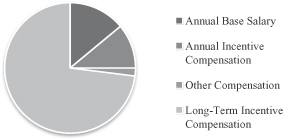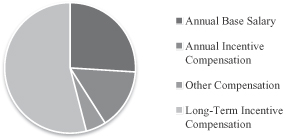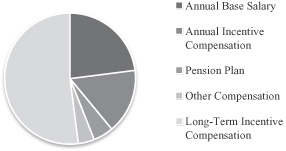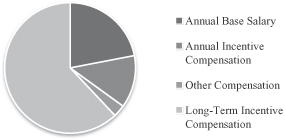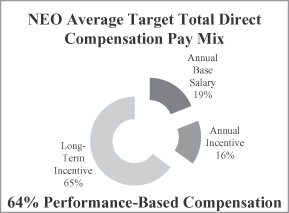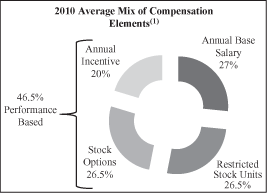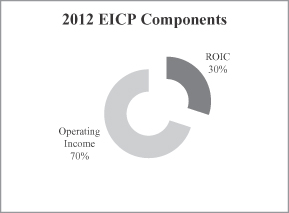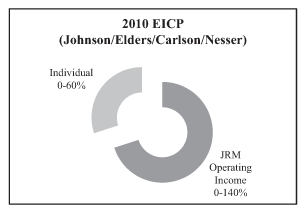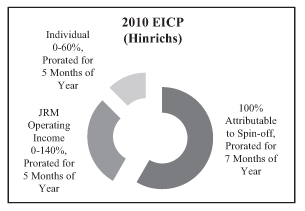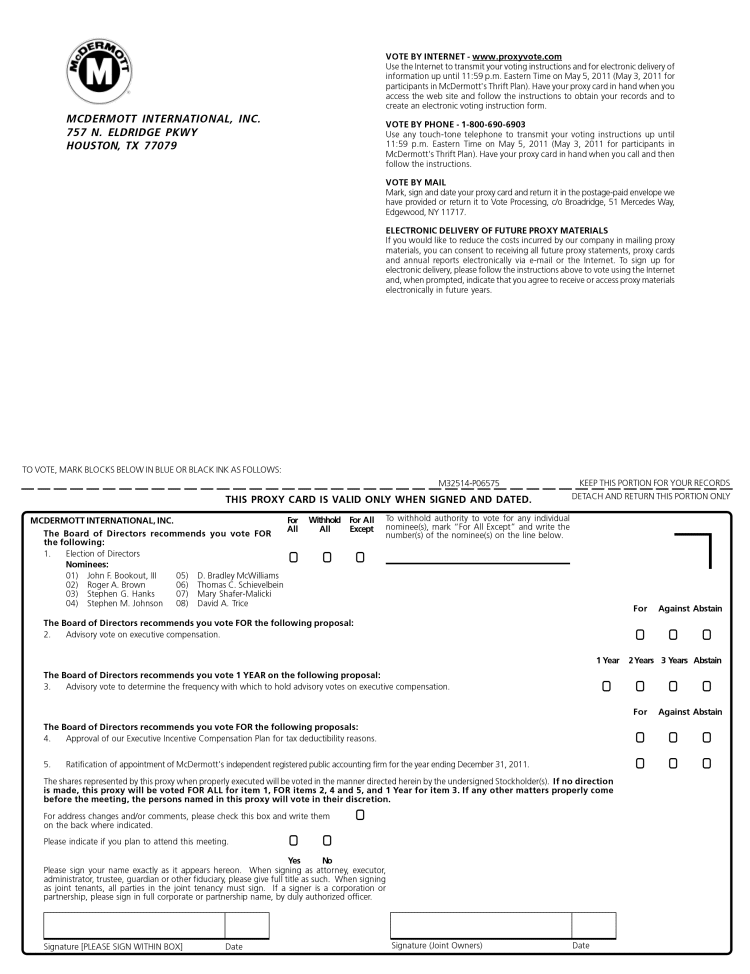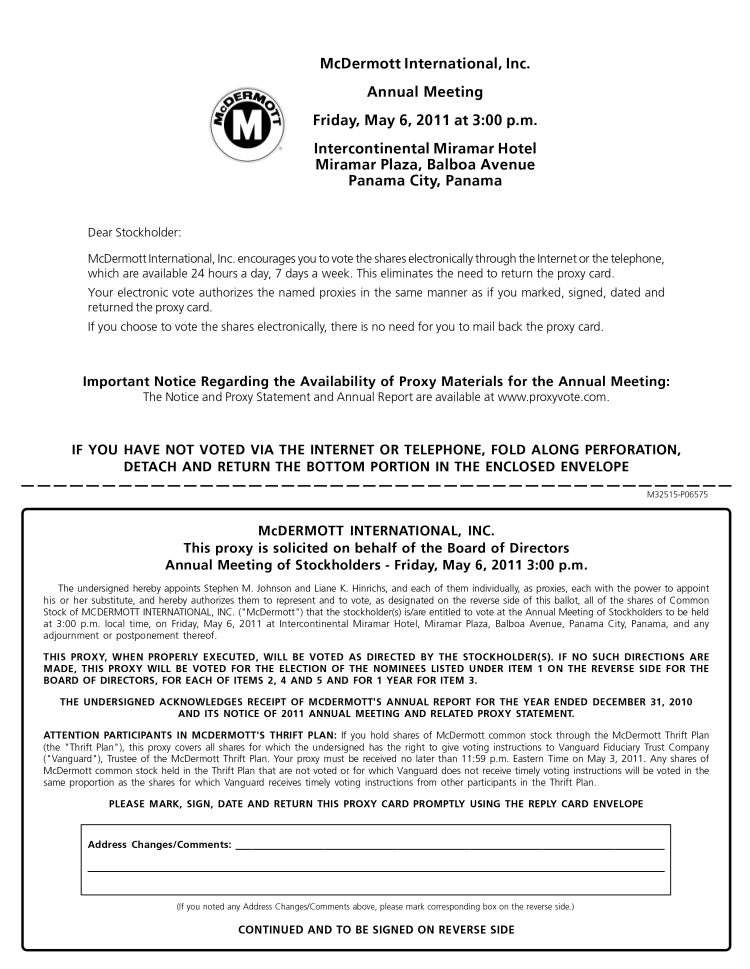| (4) | The awards in this column represent grants of performance shares, which generally may vest on the third, fourth and/or fifth anniversaries of the grant date based on the attainment of performance levels as of December 31, 2013, 2014 and 2015. The number and value of performance shares reported with a grant date of hire, all unexercisable options generally vest in three equal installments on the first, second and third anniversaries of the grant date, as follows: | | | Grant Date | | One third of grant vests on: | | | 03/05/09 | | March 5, 2011 and 2012 | 05/14/09 | | May 14, 2011 and 2012 | 03/04/10 | | March 4, 2011 2012is based on achieving threshold performance as of the December 31, 2013 measurement date. The number and 2013 | 05/13/10 | | Mr. Carlson: March 29, 2011, 2012 and 2013 | 05/13/10 | | Mr. Elders: May 13, 2011, 2012 and 2013 |
Stock Awards. Information presented in the Stock Awards columns relates to awards of restricted stock and restricted stock units held by our Named Executives as of December 31, 2010. The awards reported in the “Number of Shares or Units of Stock that have not Vested” column reflect stock awards subject to service-based vesting.
Restricted Stock Awards. With the exception of the restricted stock granted on August 2, 2010, shares of restricted stock are generally scheduled to vest in one-third increments on the first, second and third anniversaries of the grant date. The restricted stock awards granted on August 2, 2010 were granted pursuant to retention agreements we entered into with certain of our Named Executives in connection with the Spin-off. See “Compensation Discussion and Analysis — Employment and Severance Arrangements — Retention Agreements” above for more information regarding the retention agreements. The vesting schedule of the restricted stock outstanding as of December 31, 2010 is as follows:
| | | Grant Date | | Restricted Stock Awards vest: | | | 03/03/08 | | One-third of grant vests on March 3, 2011 | 08/14/08 | | One-third of grant vests on August 14, 2011 | 11/10/08 | | One-third of grant vests on November 10, 2011 | 08/02/10 | | 100% of grant vests on July 30, 2011 |
Restricted Stock Units. Restricted stock units represent the right to receive one share of our common stock for each vested restricted stock unit. With the exception of restricted stock units that were converted from performance shares in connection with the Spin-off and restricted stock units granted to Mr. Carlson, restricted stock units outstanding as of December 31, 2010 are generally scheduled to vest in one-third increments on the first, second and third anniversaries of the grant date. Restricted stock units that were converted from performance shares in connection with the Spin-off generally vest 100% on the third anniversary of the grant date, as discussed in footnote (4) to the “Outstanding Equity Awards at Fiscal Year-End” table above. Restricted stock units granted to Mr. Carlson generally vest in three equal installments on the first, second and third anniversaries of his date of hire. The vesting schedule of the restricted stock units outstanding as of December 31, 2010 is as follows:
| | | Grant Date | | Vesting Schedule: | | | 03/03/08(1)
| | 100% of grant vests on March 3, 2011 | 08/14/08(1)
| | 100% of grant vests on August 14, 2011 | 10/01/08(2)
| | 100% of grant is vested | 03/05/09 | | One-third of grant vests on March 5, 2011 and 2012 | 03/05/09(1)
| | 100% of grant vests on March 5, 2012 | 05/14/09 | | One-third of grant vests on May 14, 2011 and 2012 | 05/14/09(1)
| | 100% of grant vests on May 14, 2012 | 03/04/10 | | One-third of grant vests on March 4, 2011, 2012 and 2013 | 05/13/10 | | Mr. Carlson: One-third of grant vests on March 29, 2011, 2012 and 2013 | 05/13/10 | | Mr. Elders: One-third of grant vests on May 13, 2011, 2012 and 2013 |
| | | (1) | | The grant of restricted stock units was converted from an original grantvalue of performance shares in connectionreported with the Spin-off. | | (2) | | Thea grant date of restricted stock units was converted from an original grant ofMarch 5, 2012 is based on achieving target performance shares in connection with the Spin-off. 100%as of the grant is vested, but will settle on October 1, 2011 in accordance with the terms of Mr. Fees’ retention agreement.December 31, 2014 measurement date. |
57
OPTION EXERCISESAND STOCK VESTED Option Exercises and Stock Vested
The following Option Exercises and Stock Vested table provides additional information about the value realized by our Named ExecutivesNEOs on exercises of option awards and vesting of stock awards during the year ended December 31, 2010. | | | | | | | | | | | | | | | | | | | | | Option Awards | | Stock Awards | | | | Shares
| | | | Shares
| | | | | | Acquired
| | Value Realized
| | Acquired
| | Value Realized
| | Name | | on Exercise (#) | | on Exercise | | on Vesting (#) | | on Vesting | | S. M. Johnson | | | 0 | | | | N/A | | | | 30,995 | | | $ | 743,620.10 | | | J. A. Fees | | | 295,716 | | | $ | 1,832,421.36 | | | | 467,935 | | | $ | 7,770,761.52 | | | P. L. Elders | | | 0 | | | | N/A | | | | 0 | | | | N/A | | | M. S. Taff | | | 48,724 | | | $ | 462,249.66 | | | | 59,019 | | | $ | 1,471,140.67 | | B. C. Bethards(1) | | | 23,383 | | | $ | 332,155.52 | | | | 70,427 | | | $ | 1,783,605.96 | | | G. L. Carlson | | | 0 | | | | N/A | | | | 0 | | | | N/A | | | L. K. Hinrichs | | | 14,035 | | | $ | 205,612.75 | | | | 52,827 | | | $ | 1,274,986.04 | | | J. T. Nesser | | | 11,653 | | | $ | 169,609.42 | | | | 151,031 | | | $ | 2,847,018.83 | |
| | | | | | | | | | | | | | | | | | | | Option Awards | | | Stock Awards(1) | | | Name | | Shares Acquired on Exercise (#) | | | Value
Realized on Exercise | | | Shares Acquired on Vesting (#) | | | Value
Realized on Vesting | | S. M. Johnson | | | 0 | | | | N/A | | | | 209,208 | | | $ | 2,490,026 | | P. L. Elders | | | 0 | | | | N/A | | | | 16,137 | | | $ | 194,170 | | G. L. Carlson | | | 0 | | | | N/A | | | | 14,654 | | | $ | 192,232 | | L. K. Hinrichs | | | 0 | | | | N/A | | | | 65,975 | | | $ | 954,025 | | J. T. McCormack | | | 0 | | | | N/A | | | | 37,232 | | | $ | 530,133 | |
| (1) | The number of shares acquired on vesting reported represents the aggregate number of shares that vested during 2012 in connection with awards of restricted stock units. The value realized on vesting was calculated based on the fair market value of the underlying shares on the vesting date. The following table sets forth the number of shares withheld by McDermott to satisfy the minimum statutory withholding tax due upon vesting of such restricted stock units: |
| | | | | (1)Name | | Information provided for Mr. Bethards is through July 31, 2010. In connection with the Spin-off, Mr. Bethards’ outstanding option and stock awards were converted to B&W option and stock awards. See “Compensation Discussion and Analysis — Long-Term Incentive Compensation — ConversionShares Acquired by McDermott
on Vesting of Equity in Connection with the Spin-off” for more information.Stock Awards (#) | | S. M. Johnson | | | 68,877 | | P. L. Elders | | | 4,352 | | G. L. Carlson | | | 3,938 | | L. K. Hinrichs | | | 17,559 | | J. T. McCormack | | | 9,925 | |
Option Awards. Each stock option exercise reported in the Option Exercises and Stock Vested table was effected as a simultaneous exercise and sale, with the exception of one stock option exercise without a simultaneous sale of the underlying shares by each of Messrs. Fees, Bethards and Nesser and Ms. Hinrichs representing 98,572, 23,383, 11,653 and 14,035 shares, respectively. For simultaneous exercise and sales, the value realized on exercise was calculated based on the difference between the exercise prices of the stock options and the prices at which the shares were sold. For the exercise without a simultaneous sale of the underlying shares of options by Messrs. Fees, Bethards and Nesser and Ms. Hinrichs, the value realized on exercise was calculated based on the difference between the exercise price of the stock options and the average of the highest and lowest reported trading price of our common stock on the date of exercise.
Stock Awards. For each Named Executive, the number of shares acquired on vesting reported in the Option Exercises and Stock Vested table represents the aggregate number of shares that vested during 2010 in connection with awards of performance shares, restricted stock, restricted stock unitsand/or deferred stock units. The awards of deferred stock units reflected in this table were payable entirely in cash in an amount equal to the number of vested units multiplied by the average of the highest and lowest price of our common stock on the date of vesting. As a result, no shares of stock were actually acquired upon the vesting of these deferred stock units. The following table sets forth the amount of shares attributable to performance shares, restricted stock, restricted stock units and deferred stock units, for each Named Executive:
| | | | | | | | | | | | | | | | | | | | | | | | | | | | | | | | | | | | | Performance Shares | | Restricted Stock | | Restricted Stock Units | | Deferred Stock Units | | | | Number of
| | | | Number of
| | | | Number of
| | | | Number of
| | | | | | Shares
| | Value
| | Shares
| | Value
| | Shares
| | Value
| | Shares
| | Value
| | | | Acquired on
| | Realized
| | Acquired
| | Realized
| | Acquired
| | Realized
| | Acquired
| | Realized
| | Name | | Vesting | | on Vesting | | on Vesting | | on Vesting | | on Vesting | | on Vesting | | on Vesting | | on Vesting | | S. M. Johnson | | | 0 | | | | N/A | | | | 0 | | | | N/A | | | | 30,995 | | | $ | 743,260.10 | | | | 0 | | | | N/A | | | J. A. Fees | | | 63,600 | | | $ | 1,603,356.00 | | | | 32,880 | | | $ | 458,417.60 | | | | 362,305 | | | $ | 5,470,996.42 | | | | 9,150 | | | $ | 237,991.50 | | | P. L. Elders | | | 0 | | | | N/A | | | | 0 | | | | N/A | | | | 0 | | | | N/A | | | | 0 | | | | N/A | | | M. S. Taff | | | 33,000 | | | $ | 831,930.00 | | | | 2,296 | | | $ | 58,938.32 | | | | 19,223 | | | $ | 490,474.85 | | | | 4,500 | | | $ | 89,797.50 | | | B. C. Bethards | | | 44,400 | | | $ | 1,119,324.00 | | | | 1,310 | | | $ | 33,627.70 | | | | 24,717 | | | $ | 630,654.26 | | | | 0 | | | | N/A | | | G. L. Carlson | | | 0 | | | | N/A | | | | 0 | | | | N/A | | | | 0 | | | | N/A | | | | 0 | | | | N/A | | | L. K. Hinrichs | | | 33,300 | | | $ | 839,493.00 | | | | 8,767 | | | $ | 160,520.99 | | | | 9,890 | | | $ | 252,343.35 | | | | 870 | | | $ | 22,628.70 | | | J. T. Nesser | | | 52,500 | | | $ | 1,323,525.00 | | | | 6,153 | | | $ | 110,922.42 | | | | 85,988 | | | $ | 1,246,367.51 | | | | 6,390 | | | $ | 166,203.90 | |
58
The number of shares acquired in connection with the exercise of stock options, to the extent applicable, and the vesting of performance shares, restricted stock awards and restricted stock units includes the following number of shares withheld by us at the election of each Named Executive to satisfy the minimum statutory withholding tax due upon exercise or vesting. For more information on the withholding of shares to cover taxes due upon exercise or vesting, see the “Certain Relationships and Related Transactions” section of this proxy statement.
| | | | | | | | | | | | | Shares Acquired by McDermott
| | Shares Acquired by McDermott
| | Name | | on Exercise of Stock Options | | on Vesting of Stock Awards | | S. M. Johnson | | | N/A | | | | 11,297 | | | J. A. Fees | | | 62,550 | | | | 155,899 | | | P. L. Elders | | | N/A | | | | N/A | | | M. S. Taff | | | N/A | | | | 17,777 | | | B. C. Bethards | | | 15,744 | | | | 27,163 | | | G. L. Carlson | | | N/A | | | | N/A | | | L. K. Hinrichs | | | 8,123 | | | | 16,943 | | | J. T. Nesser | | | 7,423 | | | | 51,304 | |
59
PENSION BENEFITS Pension Benefits
The following Pension Benefits table shows the present value of accumulated benefits payable to each of our Named ExecutivesNEOs under the qualified defined benefit pension plansplan (referred to as the Retirement Plans)Plan) and nonqualified pension plansplan (referred to as the Excess Plans)Plan) that we sponsored prior to the Spin-off and those we have continued to sponsor since the Spin-off. | | | | | | | | | | | | | | | | | Present Value of
| | Payments
| | | | | | Number of Years
| | Accumulated
| | During
| | Name | | Plan Name | | Credited Service | | Benefit(1) | | 2010 | | S.M. Johnson | | N/A | | N/A | | N/A | | N/A | | | | N/A | | N/A | | N/A | | N/A | J.A. Fees(2) | | B&W Governmental Operations Retirement Plan | | 31.167 | | $1,224,477 | | $0 | | | | B&W Governmental Operations Excess Plan | | 31.167 | | $3,216,141 | | $0 | | P.L. Elders | | N/A | | N/A | | N/A | | N/A | | | | N/A | | N/A | | N/A | | N/A | | M.S. Taff | | N/A | | N/A | | N/A | | N/A | | | | N/A | | N/A | | N/A | | N/A | B.C. Bethards(3) | | B&W Governmental Operations Retirement Plan | | 37.000 | | $1,246,422 | | $0 | | | | B&W Governmental Operations Excess Plan | | 37.000 | | $1,719,768 | | $0 | | G.L. Carlson | | N/A | | N/A | | N/A | | N/A | | | | N/A | | N/A | | N/A | | N/A | | L.K. Hinrichs | | McDermott Retirement Plan | | 11.167 | | $315,251 | | $0 | | | | McDermott Excess Plan | | 11.167 | | $131,970 | | $0 | | J.T. Nesser | | McDermott Retirement Plan | | 11.750 | | $391,366 | | $0 | | | | McDermott Excess Plan | | 11.750 | | $440,724 | | $0 |
| | | | | | | | | | | | | | | | Name | | Plan Name | | Number of
Years Credited
Service | | | Present Value of
Accumulated Benefit(1) | | | Payments
During 2012 | | S. M. Johnson | | N/A | | | N/A | | | | N/A | | | | N/A | | | | N/A | | | N/A | | | | N/A | | | | N/A | | P. L. Elders | | N/A | | | N/A | | | | N/A | | | | N/A | | | | N/A | | | N/A | | | | N/A | | | | N/A | | G. L. Carlson | | N/A | | | N/A | | | | N/A | | | | N/A | | | | N/A | | | N/A | | | | N/A | | | | N/A | | L. K. Hinrichs | | McDermott Retirement Plan | | | 11.167 | | | $ | 422,505 | | | $ | 0 | | | | McDermott Excess Plan | | | 11.167 | | | $ | 185,241 | | | $ | 0 | | J. T. McCormack | | N/A | | | N/A | | | | N/A | | | | N/A | | | | N/A | | | N/A | | | | N/A | | | | N/A | |
| | | | (1) | | In connection with the Spin-off and pursuant to the Employee Matters Agreement, the accumulated pension benefits of Messrs. Fees and Bethards were transferred to B&W on June 30, 2010. The present valuesvalue of accumulated benefits provided for Messrs. Fees and Bethards arereflected above is based on a 5.6%4.0% discount rate and the 1994 Group Annuity Mortality Table projected to 2010, which are the assumptions used by B&WIRS static table for valuation years beginning in computing the present values. | | (2) | | In connection with Mr. Fees’ retirement from McDermott on July 30, 2010, Mr. Fees commenced receiving an unreduced early retirement benefit under the B&W Governmental Operations Retirement Plan as of August 1, 2010. Such payments were made by B&W and are not included in the table above. | | (3) | | The number of years of credited service for Mr. Bethards includes 0.417 years (July31-December 31, 2010) when he was no longer an employee of McDermott following the Spin-off.2013. |
Overview of Qualified Plans.Plan. The Retirement Plans we sponsor in which the eligible Named Executives participate arePlan is funded by trustsa trust and generally covercovers eligible regular full-time employees of McDermott and its subsidiaries, as described below in the section entitled “Participation and Eligibility.” Nonresident alien employees who do not earn income in the United States and temporary resident alien employees are not eligible to participate in the Retirement Plans.Plan. In reviewing pension benefits payable to our Named Executives,NEOs, it is important to note: | | | | • | Ms. Hinrichs and Mr. Nesser participated in the MI Retirement Plan until their participation was transferred to the JRM Retirement Plan through the merger of the MI |
Of the NEOs, only Ms. Hinrichs participates in the Retirement Plan; and | | | | | Retirement Plan into the JRM Retirement Plan in connection with the Spin-off; the JRM Retirement Plan was thereafter renamed the “McDermott (U.S.) Retirement Plan” (referred to herein as the “McDermott Retirement Plan”) and provides benefits for eligible McDermott employees. As of June 30, 2010, benefit accruals under the McDermott Retirement Plan were frozen for all participants, including Ms. Hinrichs and Mr. Nesser; | | | • | Mr. Fees participated in the MI Retirement Plan until his participation was transferred to the B&W Governmental Operations Retirement Plan in connection with the Spin-off; |
60During 2006, all new participation in the Retirement Plan was closed, and benefit accruals under the Retirement Plan were frozen for all participants, including Ms. Hinrichs, as of June 30, 2010.
| | | | • | Mr. Bethards participates in the B&W Governmental Operations Retirement Plan; and | | | • | Due to their respective employment dates, Messrs. Johnson, Elders, Taff and Carlson do not participate in our Retirement Plans. |
For more information on our Retirement Plans,retirement plans, see “Compensation Discussion and Analysis — Post-employment Compensation — Retirement Plans.” Participation and Eligibility.Eligibility Generally,. The Retirement Plan includes provisions related to eligibility, participation and benefit formulas for employees over the age of 21 years who were hired before April 1, 2005 are eligibleemployed by McDermott’s subsidiary J. Ray McDermott Holdings, LLC and other designated affiliates thereof, as well as for employees who were employed by McDermott Incorporated (now known as McDermott Investments, LLC) and certain former salaried employees of a subsidiary of The Babcock & Wilcox Company who transferred to participate inemployment with McDermott Incorporated. Benefits. Ms. Hinrichs’ benefits under the McDermott Retirement Plan or the B&W Governmental Operations Retirement Plan, subject to the following: | | | | • | For participants with less than five years of service as of March 31, 2006 — The plans were closed to new salaried participants and benefit accruals were frozen as of that date, butcost-of-living increases continued to be paid, as discussed further below. Affected employees received annual service-based company cash contributions to their Thrift Plan accounts. On June 30, 2010, the provision of thecost-of-living increase under the McDermott Retirement Plan was terminated, and, for affected participants, the Thrift Plan service-based contribution was replaced by a cash contribution equal to 3% of thriftable earnings. | | | • | For participants with more than five but less than ten years of service as of January 1, 2007 — If a participant made an election to do so, benefit accruals were frozen as of March 31, 2007, with the electing participants receiving annual service-based company cash contributions to their Thrift Plan accounts. As of June 30, 2010, benefit accruals under the McDermott Retirement Plan were frozen altogether, and in lieu of any service-based cash contributions, affected participants now receive a cash contribution to their Thrift Plan accounts equal to 3% of thriftable earnings. | | | • | Frozen accrued benefits of affected employees under these plans increased annually in line with increases in the Consumer Price Index, up to a maximum of 8% and a minimum of 1%, for each year the employee remained employed. However, as of June 30, 2010, the provision of thecost-of-living |
| | | | | increase under the McDermott Retirement Plan was terminated and the accrued benefits under the McDermott Retirement Plan were frozen altogether. |
Benefits. Benefits applicable to Named Executives under these Plans are calculated as follows:
| | | | • | For participants originally employed by our former Power Generation Systems or Government Operations segments (“Tenured Employees”) before April 1, 1998 (which includes Messrs. Fees and Bethards) — benefits are calculated based on years of credited service and final average cash compensation (including bonuses and commissions). | | | • | For salaried participants originally hired by our subsidiary formerly known as McDermott Incorporated on or after April 1, 1998 (which includes Mr. Nesser and Ms. Hinrichs) — benefits are calculated as 1.2% of final average monthly compensation up to the Social Security limit times credited service up to 35 years, plus 1.65% of final average monthly compensation in excess of the Social Security limit times credited service up to 35 years. Final average monthly compensation excludes bonuses and commissions. |
The present value of accumulated benefits reflectedfinal average monthly compensation as of June 30, 2010 up to the Social Security limit times credited service up to 35 years, plus 1.65% of final average monthly compensation as of June 30, 2010 in excess of the Pension Benefit Table above is based on a 5.25% discount rateSocial Security limit times credited service up to 35 years. Final average monthly compensation excludes bonuses and the 1994 Group Annuity Mortality Table projected to 2005.
commissions.Retirement and Early Retirement.Retirement. Under each of these plans,the Retirement Plan, normal retirement is age 65. The normal form of payment is a single-life annuity or a 50% joint and survivor annuity, depending on the employee’s marital status when payments are scheduled to begin. Early retirement eligibility and benefits under these plansthe Retirement Plan depend on the employee’s date of hire and age. Mr. Bethards is currently eligible for early retirement. Mr. Fees retired on July 31, 2010 and at that time was eligible for an unreduced early retirement benefit. For Tenured Employees hired before April 1, 1998 (which includes Messrs. Fees and Bethards):
| | | | • | an employee is eligible for early retirement if the employee has completed at least 15 years of credited service and attained the age of 50; and |
61
| | | | • | early retirement benefits are based on the same formula as normal retirement, but the pension benefit is unreduced if the sum of the employee’s age and years of service equals 75 or greater at the date benefits commence; otherwise the pension benefit is reduced 4% for each “point” less than 75. |
For employees hired on or after April 1, 1998:1998 (including Ms. Hinrichs):an employee is eligible for early retirement after completing at least 15 years of credited service and attaining the age of 55; and early retirement benefits are based on the same formula as normal retirement, but the pension benefit is generally reduced 0.4% for each month that benefits commence before age 62. | | | | • | an employee is eligible for early retirement after completing at least 15 years of credited service and attaining the age of 55; and | | | • | early retirement benefits are based on the same formula as normal retirement, but the pension benefit is generally reduced 0.4% for each month that benefits commence before age 62. |
Mr. Fees commenced receiving an unreduced early retirement benefit under the B&W Governmental Operations Retirement Plan as of August 1, 2010.
Neither Mr. Nesser nor Ms. Hinrichs havehas not accrued enough credited service to be eligible for early retirement under the McDermott Retirement Plan. Overview of Nonqualified Plans.(Excess) Plan. To the extent benefits payable under thesethe Retirement PlansPlan are limited by Section 415(b) or 401(a)(17) of the U.S. Internal Revenue Code, pension benefits will be paid directly by the applicable subsidiary of McDermott or B&W under the terms of the unfunded excess benefit plansplan maintained by themMcDermott (referred to as the “Excess Plans”Plan”). Effective January 1, 2006, the Excess Plans were Plan was amended to limit the annual bonus payments taken into account in calculating the Excess Plan benefits to the lesser of the actual bonus paid or 25% of the prior year’s base salary. Furthermore, because benefits entitlement under the Excess Plan and the Retirement Plan are linked, benefits under the Excess Plan have been frozen since 2006, when benefit accruals under the Retirement Plan were frozen. Ms. Hinrichs is the only NEO who participates in the Excess Plan. Mr. Nesser, Ms. Hinrichs, Mr. Fees and Mr. Bethards each participate in an Excess Plan. Mr. Fees retired on July 31, 2010 and commenced receiving an Excess Plan benefit on February 1, 2011. His benefit commencement was subject to a six-month delay following his retirement date, based on his status as a “specified employee” as defined in Code Section 409A(a)(2)(B)(i) and related IRS regulations and rulings.
62
NONQUALIFIED DEFERRED COMPENSATION Nonqualified Deferred Compensation
The following Nonqualified Deferred Compensation table summarizes our Named Executives’NEOs’ compensation under the McDermott International, Inc. Director and Executive Deferred Compensation Plan (the “Deferred Compensation Plan”). The compensation shown in this table is entirely attributable to ourthe Deferred Compensation Plan. | | | | | | | | | | | | | | | | | | | | | | | | | Executive
| | Company
| | Aggregate
| | Aggregate
| | Aggregate
| | | | Contributions in
| | Contributions in
| | Earnings
| | Withdrawals/
| | Balance
| | Name | | 2010 | | 2010 | | in 2010 | | Distributions | | at 12/31/10 | | S. M. Johnson | | $ | 0 | | | $ | 69,375 | | | $ | 7,252 | | | $ | 0 | | | $ | 76,627 | | | J. A. Fees | | $ | 0 | | | $ | 87,051 | | | $ | 49,735 | | | $ | 0 | | | $ | 422,469 | | | P. L. Elders | | $ | 0 | | | $ | 0 | | | $ | 0 | | | $ | 0 | | | $ | 0 | | | M. S. Taff | | $ | 0 | | | $ | 37,810 | | | $ | 20,439 | | | $ | 0 | | | $ | 198,227 | | | B. C. Bethards | | $ | 0 | | | $ | 52,275 | | | $ | 25,782 | | | $ | 0 | | | $ | 524,588 | | | G. L. Carlson | | $ | 0 | | | $ | 0 | | | $ | 0 | | | $ | 0 | | | $ | 0 | | | L. K. Hinrichs | | $ | 0 | | | $ | 29,549 | | | $ | 0 | | | $ | 0 | | | $ | 91,059 | | | J. T. Nesser | | $ | 0 | | | $ | 36,806 | | | $ | 83,667 | | | $ | 0 | | | $ | 746,029 | |
Overview of our Deferred Compensation Plan. OurThe Deferred Compensation Plan is an unfunded, defined contribution retirement plan for directors and officers of McDermott and its subsidiaries selected to participate by our Compensation Committee. Benefits under the Deferred CompensationCompensa-
tion Plan are based on (1) the participant’s deferral account, which is comprised of the notional account balance reflecting any executive contributions of deferred compensation, and (2) the participant’s vested percentage in his or her company account, which is comprised of the notional account balance reflecting any company contributions. A participant is at all times 100% vested in his or her deferral account. A participant generally vests in his or her company account 20% each year, subject to accelerated vesting for death, disability and termination without cause or termination within 24 months following a change in control. In connection with the Spin-off, the Deferred Compensation Plan accounts of Messrs. Fees, Taff and Bethards were transferred, and B&W assumed the liabilities of those accounts, pursuant to the Employee Matters Agreement. Executive Contributions in 2010. In November 2010, our Compensation Committee approved the deferral of eligible executives’ compensation beginning January 1, 2011. Under the terms of our Deferred Compensation Plan, an eligible executive may defer up to 50% of his or her annual salaryand/or up to 100% of any bonus earned in any year. No executive contributions were made in 2010.
Company Contributions in 2010. We make annual contributions to specified employees’ notional accounts equal to a percentage of the employee’s prior-year compensation. Under the terms of the SERP, the contribution percentage does not need to be the same for each participant. Additionally, our Compensation Committee may make a discretionary contribution to a participant’s account at any time.
With the exception of Mr. Johnson, for 2010, our contributions on behalf of Named Executives who were participants equaled 5% of the Named Executives’ base salaries and annual incentive compensation awards paid in 2009. Mr. Johnson received a company contribution in an amount equal to 5% of his prior-year base salary paid, and received a discretionary contribution equal in value to 5% of his target bonus for 2010 and the value of his prior-year target base salary for the period January 1, 2009 through his April 1, 2009 hire date. Because Messrs. Elders and Carlson were added as participants to the Deferred Compensation Plan in August 2010, no contributions were made to their respective accounts during the year. To the extent a contribution was made, all of our 2010 contributions are included in the Summary Compensation Table above as “All Other Compensation.”
Aggregate Earnings in 2010. The amount reported in this table as earnings represents hypothetical accrued gains during 2010 on each Named Executive’s account. The accounts are “participant-directed,” in that each participating officer personally directs the investment of contributions made on his or her behalf. As a result, any accrued gains or losses are
63
| | | | | | | | | | | | | | | | | | | | | | Name | | Executive
Contributions in
2012(1) | | | Company
Contributions in
2012(2) | | | Aggregate
Earnings
in 2012(3) | | | Aggregate
Withdrawals/ Distributions | | | Aggregate
Balance
at 12/31/12(4) | | S. M. Johnson | | $ | 0 | | | $ | 108,068 | | | $ | 42,526 | | | $ | 0 | | | $ | 315,501 | | P. L. Elders | | $ | 0 | | | $ | 43,970 | | | $ | 12,301 | | | $ | 0 | | | $ | 97,017 | | G. L. Carlson | | $ | 0 | | | $ | 33,320 | | | $ | 7,314 | | | $ | 0 | | | $ | 65,148 | | L. K. Hinrichs | | $ | 0 | | | $ | 37,662 | | | $ | 0 | | | $ | 0 | | | $ | 172,232 | | J. T. McCormack | | $ | 0 | | | $ | 38,828 | | | $ | 10,841 | | | $ | 0 | | | $ | 87,221 | |
attributable to the performance of the Named Executive’s notional mutual fund investments.
No amount of the earnings shown is reported as compensation in the Summary Compensation Table.
Aggregate Balance at12/31/10. The balance of a participating officer’s account consists of contributions made by us and hypothetical accrued gains or losses. The balances shown represent the accumulated account values (including gains and losses) for each Named Executive as of December 31, 2010.
The balances shown include contributions from previous years which have been reported as compensation to the Named Executives in the Summary Compensation Table for those years — to the extent a Named Executive was included in the Summary Compensation Table during those years. The amounts and years reported are as follows:
| | | | | | | | | | | | | | | Amount
| | Named Executive(1) | | Year | | Reported | | J.A. Fees | | | 2009 | | | $ | 64,774.00 | | | | | | 2008 | | | $ | 54,155.00 | | | M.S. Taff | | | 2009 | | | $ | 41,378.00 | | | | | | 2008 | | | $ | 31,125.00 | | | B.C. Bethards | | | 2009 | | | $ | 44,948.00 | | | | | | 2008 | | | $ | 31,042.00 | | | J. T. Nesser | | | 2009 | | | $ | 55,104.00 | | | | | | 2008 | | | $ | 44,926.00 | |
| | | | (1) | In November 2010, our Compensation Committee approved the deferral of eligible executives’ compensation beginning January 1, 2011. Under the terms of our Deferred Compensation Plan, an eligible executive may defer up to 50% of his or her annual salary and/or up to 100% of any bonus earned in any year. |
| (2) | We make annual contributions to specified participants’ notional accounts equal to a percentage of the participant’s prior-year compensation. Under the terms of the Deferred Compensation Plan, the contribution percentage does not need to be the same for each participant. Additionally, our Compensation Committee may make a discretionary contribution to a participant’s account at any time. In 2012, our contributions on behalf of NEOs equaled 5% of their respective base salaries paid in 2011. Those contributions are included in the Summary Compensation Table above as “All Other Compensation.” |
| (3) | The amounts reported in this column represent notional accrued gains or losses during 2012 on each NEO’s account. The accounts are “participant-directed,” in that each participant personally directs the investment of contributions made on his or her behalf. As a result, any accrued gains or losses are attributable to the performance of the NEO’s notional mutual fund investments. No informationamount of the earnings shown is providedreported as compensation in the Summary Compensation Table. |
| (4) | The amounts reported in this column consist of contributions made by McDermott and notional accrued gains or losses as of December 31, 2012. The balances shown include contributions from previous years which have been reported as compensation to the NEOs in the Summary Compensation Table for those years – to the extent a NEO was included in the Summary Compensation Table during those years. The amounts of such contributions previously included in the Summary Compensation Table and years reported are as follows: Mr. Johnson because he was notreceived contributions from McDermott of $97,932 in 2011 and $69,375 in 2010; Mr. Elders received a participantcontribution from McDermott of $39,950 in 2011; Mr. Carlson received a contribution from McDermott of $24,800 in 2011; Ms. Hinrichs received contributions from McDermott of $43,511 in 2011 and $29,549 in 2010; and Mr. McCormack received a contribution from McDermott of $36,170 in 2011. |
| As of December 31, 2012, Messrs. Johnson, Elders, Carlson and McCormack are 40% vested in their respective Deferred Compensation Plan balances shown as a result of becoming participants in the Deferred Compensation Plan prior to 2010. No information is provided for Messrs. Elders and Carlson andduring 2011. Ms. Hinrichs because they did not become Named Executives until 2010.is 100% vested in her Deferred Compensation Plan balance shown. |
POTENTIAL PAYMENTS UPON TERMINATIONOR CHANGEIN CONTROL As of December 31, 2010, Mr. Johnson is 0% vested in his Deferred Compensation Plan balance shown as a result of becoming a participant in the Deferred Compensation Plan during 2010. Messrs. Fees, Taff, Nesser and Bethards are each 100% vested in their Deferred Compensation Plan balance shown.
In May 2009, our Compensation Committee amended the Deferred Compensation Plan to vest Deferred Compensation Plan balances that were unvested as of December 31, 2008 (including future gains and losses thereon). Amounts allocated on or after January 1, 2009 vest pursuant to the participant’s vested percentage, based on years of participation. Accordingly, Ms. Hinrichs is 72.95% vested in her Deferred Compensation Plan balance shown.
64
Potential Payments Upon Termination or Change in Control
The following tables show potential payments to certain of our Named ExecutivesNEOs under existing contracts, agreements, plans or arrangements, whether written or unwritten, for various scenarios under which a payment would be due (assuming each is applicable) involving a change in control or termination of employment of each of our Named Executives,NEOs, assuming a December 31, 20102012 termination date and, where applicable, using the closing price of our common stock of $20.69$11.02 as of December 31, 2012 (as reported on the New York Stock Exchange) as of December 31, 2010.. These tables do not reflect amounts that would be payable to the Named ExecutivesNEOs pursuant to benefits or awards that are already vested. The amounts reported in the below tables for stock options, restricted stock units and restricted stock units,performance shares represent the value of unvested and accelerated shares or units, as applicable, calculated by: | | | | • | for stock options: multiplying the number of accelerated options by the difference between the exercise price and $11.02 (the closing price of our common stock on December 31, 2012, as reported on the New York Stock Exchange); and for restricted stock units and performance shares: multiplying the number of accelerated options by the difference |
| | | | | between the exercise price and $20.69 (the closing price of our common stock on December 31, 2010, as reported on the New York Stock Exchange); and | | | • | for restricted stock and restricted stock units: multiplying the number of accelerated shares or units by $20.69 (the closing price of our common stock on December 31, 2010, as reported on the New York Stock Exchange). |
In connection with the Spin-off, Messrs. Fees, Taff and Bethards terminated employment with McDermott effective July 30, 2010. Because Mr. Taff joined B&W following the Spin-off, and Mr. Bethards continued employment with B&W following the Spin-off, no termination event occurred under which they were entitled to any payments. Payments made to Mr. Fees in connection with his termination are discussed below under the “Estimated Value of Benefits to Be Received Upon Termination under the Restructuring Transaction Retention Agreements” table.
Estimated Value of Benefits to Be Received Upon Termination under the Restructuring Transaction Retention Agreements
The following table shows the estimated value of payments and other benefits due to certain of the Named Executives assuming termination under the restructuring transaction retention agreements as of December 31, 2010.
| | | | | | | | | | | | | | | | | | | | | | | | | S.M. Johnson | | P.L. Elders | | G.L. Carlson | | L.K. Hinrichs | | J.T. Nesser | | Severance Payments | | $ | 3,361,042 | | | | — | | | | — | | | $ | 1,305,748 | | | $ | 1,738,126 | | | EICP | | $ | 920,000 | | | | — | | | | — | | | $ | 232,265 | | | $ | 358,750 | | | Deferred Compensation Plan | | $ | 76,627 | | | | — | | | | — | | | $ | 24,634 | | | | — | | | Benefits | | $ | 8,843 | | | | — | | | | — | | | $ | 2,664 | | | $ | 26,974 | | | Thrift Plan | | $ | 12,658 | | | | — | | | | — | | | | — | | | | — | | | Stock Options (unvested and accelerated) | | $ | 1,931,720 | | | | — | | | | — | | | $ | 818,795 | | | $ | 679,839 | | | Restricted Stock (unvested and accelerated) | | | — | | | | — | | | | — | | | $ | 207,583 | | | $ | 173,899 | | | Restricted Stock Units (unvested and accelerated) | | $ | 4,643,891 | | | | — | | | | — | | | $ | 2,067,697 | | | $ | 1,422,293 | | TaxGross-Up | | | — | | | | — | | | | — | | | | — | | | | — | | | | | | | | | | | | | | | | | | | | | | | | Total | | $ | 10,954,781 | | | | — | | | | — | | | $ | 4,659,386 | | | $ | 4,399,881 | |
In contemplation of the Spin-off, on December 10, 2009, we entered into retention agreements with certain key members of our management, including Messrs. Johnson and Nesser and Ms. Hinrichs. The retention agreements provide either a retention or severance payment to these employees in connection with the disposition of all or substantially all of the stock or assets of B&W or JRM (whether by a spin-off, sale or otherwise), which we have referred to
as a “restructuring transaction” in the retention agreements. In the event the applicable employee is terminated prior to the first anniversary of the effective date of the restructuring transaction, either (1) by the employer company for any reason other than cause or disability or (2) by the employee for good reason, the employer company would be required to pay the employee a cash severance payment, an EICP payment, 200% of the annual cost of coverage for medical,
65
dental and vision benefits, and an amount equal to the unvested portion of the Named Executive’s Thrift Plan account. The employee would also receive accelerated vesting with respect to the unvested portion of his or her Deferred Compensation Plan account balance and certain of his or her outstanding, unvested equity awards.
Severance Payment. The severance payment that would be made to the applicable Named Executive in connection with his or her termination of employment is a cash payment equal to 200% of the sum of his or her annual base salary prior to termination and his or her EICP target award applicable to the year in which the termination occurs. For a hypothetical termination as of December 31, 2010, the severance payment under a restructuring transaction would have been calculated in the same manner as a severance payment under a change in control. For more information, see “Estimated Value of Benefits to be Received Upon Change in Control — Severance Payment.” Severance payments under a restructuring transaction would be in lieu of any payment under any severance policy generally applicable to the salaried employees of McDermott.
EICP Payment. The EICP Payment that would be made to each applicable Named Executive in connection with his or her termination of employment would be calculated in the same manner as an EICP Payment under a change in control. For more information, see “Estimated Value of Benefits to be Received Upon Change in Control — EICP Payment” below.
Deferred Compensation Plan. The amounts reported represent 100% of Mr. Johnson’s and 27.05% of Ms. Hinrichs’ respective Deferred Compensation Plan balance as of December 31, 2010 that would become vested if terminated under the retention agreements.
Benefits. The amounts reported represent two times the full annual cost of coverage for medical, dental and vision benefits provided to the applicable Named Executive and the Named Executive’s covered dependents for the year ended December 31, 2010.
Thrift Plan. The amount reported represents the unvested portion of the Named Executive’s Thrift Plan account balance as of December 31, 2010.
Equity Awards. The amounts reported for stock options, restricted stock and restricted stock units represent the value of unvested and accelerated shares or units by $11.02 (the closing price of our common stock on December 31, 2012, as applicable, for the 2008 and 2009 grants of such awards. The amount reported for restricted stock units also includes the value of unvested and accelerated units resulting from the conversion of the 2008 and 2009 grants of performance shares into restricted stock units in connection with the Spin-off. For more information on the conversion or adjustment of equity awards, see “Compensation Discussion and Analysis — Long-Term Incentive Compensation — Treatment of Equity-Based Awards in Connection with the Spin-off”New York Stock Exchange).
Mr. Fees terminated his employment with McDermott for good reason effective July 30, 2010. In connection with his termination, Mr. Fees received (1) a cash severance payment in the amount of $5,516,550, (2) payment of his 2010 target EICP award, prorated to take into account his length of service in 2010, in the amount of $535,808, (3) two times the full annual cost of coverage for medical, dental and vision benefits in the amount of $30,257, (4) unused vacation for 2010 in the amount of $70,962, (5) the value of unvested and accelerated stock options in the amount of $1,360,294, (6) the value of unvested and accelerated restricted stock in the amount of $379,354, and (7) the value of unvested and accelerated restricted stock units in the amount of $3,698,622. Mr. Fees also was fully vested in a grant of 144,540 restricted stock units that have not settled in accordance with his retention agreement. The value of these restricted stock units, less a number of restricted stock units that were forfeited in connection with the payment of certain taxes, will be determined on the original measurement date, which is October 1, 2011.
In addition, Mr. Fees received, in accordance with the Employee Matters Agreement, a number of shares of B&W common stock generally equal to the number of shares that would have been distributed in the Spin-off with respect to the number of shares of McDermott common stock received on his vested McDermott equity awards. His outstanding McDermott equity was converted pursuant to the Employee Matters Agreement.
66
Estimated Value of Benefits to Be Received Upon Retirement
The following table shows the estimated value of payments and other benefits due the Continuing Named Executives assuming their retirement as of December 31, 2010. This table does not reflect amounts that would be payable pursuant to benefits or awards that are already vested; for example, pension benefits. See the “Pension Benefits” table above for more information on pension benefits. Mr. Nesser informed the Company that he intends to retire by year-end 2011.
| | | | | | | | | | | | | | | | | | | | | | | | | S.M. Johnson | | | P.L. Elders | | | G.L. Carlson | | | L.K. Hinrichs | | | J.T. Nesser | | | Severance Payments | | | — | | | | — | | | | — | | | | — | | | | — | | | EICP | | | — | | | | — | | | | — | | | | — | | | | — | | | Deferred Compensation Plan | | | — | | | | — | | | | — | | | | — | | | | — | | | Stock Options (unvested and accelerated) | | | — | | | | — | | | | — | | | | — | | | $ | 169,960 | | | Restricted Stock (unvested and accelerated) | | | — | | | | — | | | | — | | | | — | | | $ | 86,950 | | | Restricted Stock Units (unvested and accelerated) | | | — | | | | — | | | | — | | | | — | | | | — | | | | | | | | | | | | | | | | | | | | | | | | Total | | $ | 0.00 | | | $ | 0.00 | | | $ | 0.00 | | | $ | 0.00 | | | $ | 256,910 | |
Deferred Compensation Plan. Under the terms of the Deferred Compensation Plan, participants are eligible for retirement upon attaining age 65. None of the Named Executives are currently eligible for retirement under the terms of the Deferred Compensation Plan.
Equity Awards. Generally, the terms of our restricted stock and option award grants define retirement as a voluntary termination of employment after attaining age 60 and completing 10 years of service with McDermott, and the terms of our restricted stock unit award grants define retirement as attaining age 60 and completing 10 years of service with McDermott. Under this definition, the only Named Executive eligible for retirement as of a December 31, 2010 is Mr. Nesser. With the exception of grants of restricted
stock under the retention agreements, the outstanding grants of restricted stock and the unvested grants of stock options provide for accelerated vesting of a percentage of the Named Executive’s outstanding shares if his or her retirement date is on or after the first anniversary of the grant date, and a greater percentage of accelerated vesting if his or her retirement date is on or after the second anniversary of the grant date. The outstanding grants of restricted stock units provide for accelerated vesting of a percentage of the Named Executive’s outstanding units if the date he or she becomes retirement eligible is on or after the first anniversary of the grant date, and a greater percentage of accelerated vesting if he or she becomes retirement eligible on or after the second anniversary of the grant date.
67
Estimated Value of Benefits to Be Received Upon Termination Due to Death or Disability The following table shows the value of payments and other benefits due the Continuing Named ExecutivesNEOs assuming their death or disability as of December 31, 2010. | | | | | | | | | | | | | | | | | | | | | | | | | S.M. Johnson | | P.L. Elders | | G.L. Carlson | | L.K. Hinrichs | | J.T. Nesser | | Severance Payments | | | — | | | | — | | | | — | | | | — | | | | — | | | EICP | | | — | | | | — | | | | — | | | | — | | | | — | | | Deferred Compensation Plan | | $ | 76,627 | | | | — | | | | — | | | $ | 24,634 | | | | — | | | Stock Options (unvested and accelerated) | | $ | 3,007,857 | | | $ | 441,337 | | | $ | 184,383 | | | $ | 1,163,174 | | | $ | 959,655 | | | Restricted Stock (unvested and accelerated) | | $ | 2,346,494 | | | | — | | | | — | | | $ | 1,287,559 | | | $ | 1,611,399 | | | Restricted Stock Units (unvested and accelerated) | | $ | 6,619,641 | | | $ | 799,896 | | | $ | 815,414 | | | $ | 2,699,900 | | | $ | 1,935,984 | | | | | | | | | | | | | | | | | | | | | | | | Total | | $ | 12,050,619 | | | $ | 1,241,233 | | | $ | 999,797 | | | $ | 5,175,267 | | | $ | 4,507,038 | |
Deferred Compensation Plan. The amount reported represents 100% of Mr. Johnson’s and 27.05% of Ms. Hinrichs’ respective Deferred Compensation Plan balance as of December 31, 2010 that would become vested on death or disability. Each of Messrs. Elders and Carlson has a zero balance in his Deferred Compensation Plan account as of December 31, 2010. Mr. Nesser was 100% vested in his
Deferred Compensation Plan balance as of December 31, 2010.
Equity Awards. Under the terms of the awards outstanding for each Named Executive as of December 31, 2010, all unvested stock awards become vested and all unvested option awards become vested and exercisable on death or disability.
68
| | | | | | | | | | | | | | | | | | | | | | | | S.M. Johnson | | | P.L. Elders | | | G.L. Carlson | | | L.K. Hinrichs | | | J.T. McCormack | | Severance Payments | | | — | | | | — | | | | — | | | | — | | | | — | | EICP | | | — | | | | — | | | | — | | | | — | | | | — | | Deferred Compensation Plan(1) | | $ | 189,301 | | | $ | 58,210 | | | $ | 39,089 | | | $ | 0 | | | $ | 52,333 | | Stock Options(2) (unvested and accelerated) | | $ | 0 | | | $ | 0 | | | $ | 0 | | | $ | 0 | | | $ | 0 | | Restricted Stock Units(3) (unvested and accelerated) | | $ | 1,591,255 | | | $ | 471,182 | | | $ | 321,288 | | | $ | 376,609 | | | $ | 441,979 | | Performance Shares(4) (unvested) | | $ | 1,818,168 | | | $ | 478,411 | | | $ | 319,393 | | | $ | 379,165 | | | $ | 555,177 | | Total | | $ | 3,598,724 | | | $ | 1,007,803 | | | $ | 679,770 | | | $ | 755,774 | | | $ | 1,049,489 | |
| (1) | The amounts reported represent 60% of Messrs. Johnson’s, Elders’, Carlson’s and McCormack’s respective Deferred Compensation Plan balance as of December 31, 2012 that would become vested on his death or disability. Because Ms. Hinrichs is 100% vested in her Deferred Compensation Plan balance, no additional amount would become vested on her death or disability. |
| (2) | Under the terms of the stock option awards outstanding for each of the NEOs as of December 31, 2012, all unvested option awards would become vested and exercisable on death or disability. Due to the exercise price of the stock options outstanding and the closing price of our common stock on December 31, 2012, the aggregate value of stock options that would become vested and exercisable on death or disability for all NEOs would be $0. |
| (3) | Under the terms of the restricted stock unit awards outstanding for each of the NEOs as of December 31, 2012, all unvested restricted stock unit awards would become vested and exercisable on his or her death or disability. |
| (4) | Under the terms of the performance share awards outstanding for each of the NEOs as of December 31, 2012, 100% of the initial performance shares granted would vest on the third, fourth and fifth anniversary of the grant date on his or her death or disability. The number of performance shares that would vest is the number of performance shares that would have vested based on actual performance had the NEO remained employed with McDermott until the third, fourth and fifth anniversaries of the grant date. Accordingly, each NEO may vest in a number of performance shares ranging from 0% — 200% of the initial performance shares granted, depending on McDermott’s total shareholder return relative to its peers during the applicable measurement periods. The amounts reported assume a total of 100% of the initial performance shares granted will vest during the applicable measurement periods, valued at the closing price of McDermott stock as reported on the NYSE on December 31, 2012, although the actual value of such performance shares that may vest on the third, fourth and fifth anniversary of the date of grant could be $0 for each NEO and up to $3,636,336 for Mr. Johnson, $956,823 for Mr. Elders, $638,785 for Mr. Carlson, $758,330 for Ms. Hinrichs and $1,110,353 for Mr. McCormack, in each case representing a total of 200% of the initial performance shares granted. Additionally, the value of McDermott stock could be greater or less than the amount used to value the performance shares for this table. |
Estimated Value of Benefits to Be Received Upon Change in Control The following table shows the estimated value of payments and other benefits due the Continuing Named Executives assuming a change in control and termination as of December 31, 2010.
| | | | | | | | | | | | | | | | | | | | | | | | | S.M. Johnson | | P.L. Elders | | G.L. Carlson | | L.K. Hinrichs | | J.T. Nesser | | Severance Payments | | $ | 5,024,758 | | | $ | 1,378,666 | | | $ | 992,000 | | | $ | 1,305,748 | | | $ | 1,738,126 | | | EICP | | $ | 920,000 | | | $ | 329,000 | | | $ | 176,000 | | | $ | 232,265 | | | $ | 358,750 | | | Deferred Compensation Plan | | $ | 76,627 | | | | — | | | | — | | | $ | 24,634 | | | | — | | | Stock Options (unvested and accelerated) | | $ | 3,007,857 | | | $ | 441,337 | | | $ | 184,383 | | | $ | 1,163,174 | | | $ | 959,655 | | | Restricted Stock (unvested and accelerated) | | $ | 2,346,494 | | | | — | | | | — | | | $ | 1,287,559 | | | $ | 1,611,399 | | | Restricted Stock Units (unvested and accelerated) | | $ | 6,619,641 | | | $ | 799,896 | | | $ | 815,414 | | | $ | 2,699,900 | | | $ | 1,935,984 | | | | | | | | | | | | | | | | | | | | | | | | Total | | $ | 17,995,377 | | | $ | 2,948,899 | | | $ | 2,167,797 | | | $ | 6,713,280 | | | $ | 6,603,914 | |
We havechange-in-control agreements with various officers, including each of our Named Executives.NEOs. Generally, under these agreements, if a Named ExecutiveNEO is terminated within one year following a change in control either (1) by the company for any reason other than cause or death or disability;disability, or (2) by the Named ExecutiveNEO for good reason, the companyMcDermott is required to pay the Named ExecutiveNEO a cash severance payment based on the NEO’s salary and ana severance payment based on the NEO’s target EICP payment.percentage. In addition to these payments, the Named ExecutiveNEO would be entitled to various accrued benefits earned through the date of termination, such as earned but unpaid salary, earned but unused vacation and reimbursements. Under these agreements, a “change in control” generally occurs on the occurrence of any of the following: a person becomes the beneficial owner of 30% or more of the combined voting power of McDermott’s then outstanding voting stock unless such acquisition is made directly from McDermott in a transaction approved by a majority of McDermott’s incumbent directors; individuals who are incumbent directors cease for any reason to constitute a majority of McDermott’s board; completion of a merger or consolidation of McDermott with another company or an acquisition by McDermott or its subsidiaries, unless immediately following such merger, consolidation or acquisition: (1) all or substantially all of the individuals or entities that were the beneficial owners of outstanding McDermott voting securities immediately before such merger, consolidation or acquisition beneficially own at least 50% of the then outstanding shares of voting stock of the parent corporation resulting from the merger, consolidation or acquisition in the same relative proportions as their ownership immediately before such merger, consolidation or acquisition; (2) if such merger, consolidation or acquisition involves the issuance or payment by | | | | • | a person becomes the beneficial owner of 30% or more of the combined voting power of McDermott’s then outstanding voting stock unless such acquisition is made directly from McDermott in a transaction approved by a majority of McDermott’s incumbent directors; | | | • | individuals who are incumbent directors cease for any reason to constitute a majority of McDermott’s board; | | | • | completion of a merger or consolidation of McDermott with another company or an acquisition by McDermott or its subsidiaries, unless immediately following such merger, consolidation or acquisition: (1) all or substantially all of the individuals or entities that were the beneficial owners of outstanding McDermott voting securities immediately before such merger, consolidation or |
| | | | | | acquisition beneficially own at least 50% of the then outstanding shares of voting stock of the parent corporation resulting from the merger, consolidation or acquisition in the same relative proportions as their ownership immediately before such merger, consolidation or acquisition; (2) if such merger, consolidation or acquisition involves the issuance or payment by McDermott of consideration to another entity or its shareholders,stockholders, the total fair market value of such consideration plus the principal amount of the consolidated long-term debt of the entity or business being acquired, does not exceed 50% of the sum of the fair market value of the outstanding McDermott voting stock plus the principal amount of the Company’s consolidated long-term debt; (3) no person beneficially owns 30% or more of the then outstanding shares of the voting stock of the parent company resulting from such merger, consolidation or acquisition; and (4) a majority of the members of the board of directors of the parent corporation resulting from such merger, consolidation or acquisition were incumbent directors of McDermott immediately before such merger, consolidation or acquisition; | | | • | completion of the sale or disposition of 50% or more of the assets of McDermott and its subsidiaries on a consolidated basis, unless immediately following such sale or disposition: (1) the individuals and entities that were beneficial owners of outstanding McDermott voting stock immediately before such sale or disposition beneficially own at least 50% of the then outstanding shares of voting |
completion of the sale or disposition of 50% or more of the assets of McDermott and its subsidiaries on a consolidated basis, unless immediately following such sale or disposition: (1) the individuals and entities that were beneficial owners of outstanding McDermott voting stock immediately before such sale or disposition beneficially own at least 50% of the then outstanding shares of voting stock of McDermott and of the entity that acquires the largest portion of such assets, and (2) a majority of the members of the McDermott Board (if it continues to exist) and the board of directors of the entity that acquires the largest portion of such assets were incumbent directors of McDermott immediately before the completion of such sale or disposition; or any other set of circumstances is deemed by the Board in its sole discretion to constitute a change in control.
69The change-in-control agreements do not provide for excise tax gross-ups. They do, however, provide for the potential reduction in payments to the applicable officer in order to avoid excise taxes.
The following table shows the estimated value of payments and other benefits due the NEOs assuming a change in control and termination as of December 31, 2012. | | | | | | | | | | | | | | | | | | | | | | | | S.M. Johnson | | | P.L. Elders | | | G.L. Carlson | | | L.K. Hinrichs | | | J.T. McCormack | | Salary-Based Severance Payment(1) | | $ | 5,681,000 | | | $ | 1,691,279 | | | $ | 1,252,325 | | | $ | 1,538,279 | | | $ | 1,976,131 | | EICP-Based Severance Payment(2) | | $ | 950,000 | | | $ | 350,000 | | | $ | 262,500 | | | $ | 318,500 | | | $ | 448,000 | | Deferred Compensation Plan(3) | | $ | 189,301 | | | $ | 58,210 | | | $ | 39,089 | | | $ | 0 | | | $ | 52,333 | | Stock Options(4) (unvested and accelerated) | | $ | 0 | | | $ | 0 | | | $ | 0 | | | $ | 0 | | | $ | 0 | | Restricted Stock Units(4) (unvested and accelerated) | | $ | 1,591,255 | | | $ | 471,182 | | | $ | 321,288 | | | $ | 376,609 | | | $ | 441,979 | | Performance Shares(4) (unvested and accelerated) | | $ | 1,818,167 | | | $ | 478,411 | | | $ | 319,393 | | | $ | 379,165 | | | $ | 555,177 | | Total | | $ | 10,229,723 | | | $ | 3,049,082 | | | $ | 2,194,595 | | | $ | 2,612,553 | | | $ | 3,473,620 | |
| (1) | | | | | stock of McDermott and of the entity that acquires the largest portion of such assets, and (2) a majority of the members of the McDermott Board (if it continuesThe salary-based severance payment made to exist) and the board of directors of the entity that acquires the largest portion of such assets were incumbent directors of McDermott immediately before the completion of such sale or disposition; or |
| | | | • | any other set of circumstances is deemed by the Board in its sole discretion to constitute a change in control. |
Severance Payment. The severance payment made to each Continuing Named Executive,each NEO, with the exception of Mr. Johnson, in connection with a change in control would be a cash payment equal to 200% of the sum of his or her annual base salary prior to termination and his or her EICP target award applicable to the year in which the termination occurs. The severance payment made to Mr. Johnson in connection with a change in control would be a cash payment equal to 299% of the sum of his annual base salary prior to termination and his EICP target award applicable to the year in which the termination occurs. The severance payment made to Mr. Johnson in connection with a change in control would be a cash payment equal to 299% of the sum of his annual base salary prior to termination and his EICP target award applicable to the year in which the termination occurs.
|








